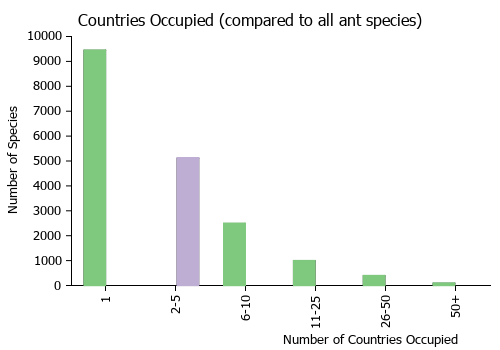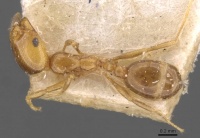Solenopsis gensterblumi
| Solenopsis gensterblumi | |
|---|---|

| |
| Scientific classification | |
| Kingdom: | Animalia |
| Phylum: | Arthropoda |
| Class: | Insecta |
| Order: | Hymenoptera |
| Family: | Formicidae |
| Subfamily: | Myrmicinae |
| Tribe: | Solenopsidini |
| Genus: | Solenopsis |
| Species complex: | nigella |
| Species: | S. gensterblumi |
| Binomial name | |
| Solenopsis gensterblumi Forel, 1901 | |
| Synonyms | |
| |
Nothing is known about the biology of Solenopsis gensterblumi.
Identification
A New World thief ant that is a member of the nigella species complex.
Pacheco and Mackay (2013) – Worker - The worker ranges in color from concolorous golden yellow to brown. What is striking about this species are the large eyes (20-25 ommatidia). It is nearly devoid of pilosity and sculpturing and is smooth and shiny on all body surfaces. The petiolar peduncle has a well-developed ventral tooth.
Apparently S. gensterblumi is a minor worker and Solenopsis nigella is the major of the same species-level taxon. It appears that S. nigella is dimorphic, but with the little evidence (no complete series), we will recognize S. gensterblumi as a valid species. However, if and when a complete series is collected, S. gensterblumi will probably be synonymized with S. nigella.
Keys including this Species
Distribution
Latitudinal Distribution Pattern
Latitudinal Range: -31.771° to -31.771°.
| North Temperate |
North Subtropical |
Tropical | South Subtropical |
South Temperate |
- Source: AntMaps
Distribution based on Regional Taxon Lists
Neotropical Region: Argentina (type locality), Brazil (type locality).
Distribution based on AntMaps
Distribution based on AntWeb specimens
Check data from AntWeb
Countries Occupied
| Number of countries occupied by this species based on AntWiki Regional Taxon Lists. In general, fewer countries occupied indicates a narrower range, while more countries indicates a more widespread species. |

|
Estimated Abundance
| Relative abundance based on number of AntMaps records per species (this species within the purple bar). Fewer records (to the left) indicates a less abundant/encountered species while more records (to the right) indicates more abundant/encountered species. |

|
Biology
Castes
Images from AntWeb
   
| |
| Lectotype of Solenopsis picta gensterblumi. Worker. Specimen code casent0908845. Photographer Will Ericson, uploaded by California Academy of Sciences. | Owned by MHNG, Geneva, Switzerland. |
Queens have yet to be collected.
Nomenclature
The following information is derived from Barry Bolton's Online Catalogue of the Ants of the World.
- gensterblumi. Solenopsis picta r. gensterblumi Forel, 1901d: 298 (w.) BRAZIL (Rio Grande do Sul).
- Type-material: syntype workers (numbers not stated).
- Type-locality: Brazil: Pelotas (Gensterblum).
- [Note: Pacheco & Mackay, 2013: 159, mistakenly give the type-locality as Argentina: Bueos Aires, Serra de la Ventana (Bruch), and incorrectly designate a lectotype + paralectotypes from this series; the designation is redundant.]
- Type-depository: MHNG.
- [Misspelled as gerstenblumi by Emery, 1922e: 200, Borgmeier, 1927c: 106.]
- Subspecies of picta: Forel, 1908c: 364; Forel, 1911c: 298; Luederwaldt, 1918: 43; Emery, 1922e: 200; Borgmeier, 1927c: 106; Ettershank, 1966: 141.
- Subspecies of nigella: Creighton, 1930b: 132; Kempf, 1972a: 238; Bolton, 1995b: 388.
- Status as species: Pacheco & Mackay, 2013: 158 (redescription).
- Senior synonym of carettei: Pacheco & Mackay, 2013: 158.
- Senior synonym of prevalens: Creighton, 1930b: 132; Kempf, 1972a: 238; Bolton, 1995b: 388; Pacheco & Mackay, 2013: 158.
- Distribution: Argentina, Brazil.
- carettei. Solenopsis angulata r. carettei Forel, 1913l: 223 (w.) ARGENTINA (Mendoza).
- Type-material: lectotype worker (by designation of Pacheco & Mackay, 2013: 159), 4 paralectotype workers.
- Type-locality: lectotype Argentina: Mendoza (C. Bruch); paralectotypes with same data.
- Type-depository: MHNG.
- Subspecies of angulata: Forel, 1914d: 278; Bruch, 1914: 222; Bruch, 1915: 531; Bruch, 1916: 319; Santschi, 1916b: 510; Santschi, 1916e: 378; Gallardo, 1919b: 245; Emery, 1922e: 199; Santschi, 1929d: 298; Creighton, 1930b: 149; Ettershank, 1966: 140; Kempf, 1972a: 233; Bolton, 1995b: 386.
- Junior synonym of gensterblumi: Pacheco & Mackay, 2013: 158.
- prevalens. Solenopsis nigella st. prevalens Santschi, 1923c: 257 (s.w.) ARGENTINA (Buenos Aires).
- Type-material: syntype workers (number not stated).
- Type-locality: Argentina: La Plata (C. Bruch).
- [Note: Pacheco & Mackay, 2013: 159, record 5 “cotype” (= syntype) workers from Argentina: Alta Gracia, in MCZC, but this locality is not mentioned in the original description.]
- Type-depository: NHMB.
- Santschi, 1929d: 297 (m.).
- Subspecies of nigella: Santschi, 1929d: 297.
- Junior synonym of gensterblumi: Creighton, 1930b: 132; Kempf, 1972a: 238; Bolton, 1995b: 390; Pacheco & Mackay, 2013: 158.
Unless otherwise noted the text for the remainder of this section is reported from the publication that includes the original description.
Description
Worker
Pacheco and Mackay (2013) - Measurements (n=14). TL 1.37-1.62 (1.53); HL 0.408-0.528 (0.483); HW 0.300-0.468 (0.410); EL 0.042-0.090 (0.079); ED 0.030-0.060 (0.053); SL 0.282-0.360 (0.308); FSL 0.090-0.144 (0.126); CI 71.4-92.6 (85.0); SI 58.1-72.3 (64.0); PL 0.066-0.078 (0.073); PW 0.078-0.102 (0.091); PI 70.6-92.3 (80.2); PPL 0.090-0.120 (0.102); PPW 0.120-0.138 (0.128); PPI 68.2-95.2 (79.6); WL 0.300-0.360 (0.309); PSL 0.024; PSW 0.018-0.024 (0.020).
Small, concolorous golden yellow to dark brown; head quadrate, longer than wide, with posterior border slightly concave; lateral clypeal teeth angulate; extralateral teeth absent; clypeal carinae well defined; scape does not reach posterior border of head; eyes large, oval shaped, approximately 20-25 ommatidia; pronotum and mesopleuron smooth and shiny; notopropodeal suture weakly depressed, groove breaks sculpture of mesosoma; metapleuron horizontally striated; posterior propodeal edge angulate, with ridge; petiolar node wider than postpetiole viewed laterally, petiole triangular shaped with sharp anterior and posterior faces; well defined tooth present ventrally on subpeduncular process.
Not very pilose; few hairs present on all body surfaces; neither head nor scape heavily pilose, with only small suberect hairs present that are roughly 0.018 mm in length; mesosoma, petiole, postpetiole and gaster have very few hairs that range from 0.018 to 0.024 mm in length.
Type Material
Pacheco and Mackay (2013) - Argentina, Buenos Aires, Serra de la Ventana, Sierra Ventana, (460, Bruch) Forel Coll. (lectotype worker [here designated] and 4 paralectotype workers Musee d'Histoire Naturelle Genève). Solenopsis nigella prevalens, Argentina, Alta Gracia, (Bruch) M.C.Z.C. 1-5, 20931 (5 worker cotypes Museum of Comparative Zoology). Solenopsis angulata carettei, (1 lectotype worker [here designated] and 4 paralectotype workers MHNG).
References
- Creighton, W. S. 1930b. The New World species of the genus Solenopsis (Hymenop. Formicidae). Proc. Am. Acad. Arts Sci. 66: 39-151 (page 132, Subspecies of nigella, and senior synonym of prevalens)
- Forel, A. 1901g. Einige neue Ameisen aus Südbrasilien, Java, Natal und Mossamedes. Mitt. Schweiz. Entomol. Ges. 10: 297-311 (page 298, worker described)
- Pacheco, J.A. & Mackay, W.P. 2013. The systematics and biology of the New World thief ants of the genus Solenopsis (Hymenoptera: Formicidae). Edwin Mellen Press, Lewiston, New York. 501 pp.
References based on Global Ant Biodiversity Informatics
- Creighton W. S. 1930. The New World species of the genus Solenopsis (Hymenop. Formicidae). Proceedings of the American Academy of Arts and Sciences 66: 39-151.
- Cuezzo, F. 1998. Formicidae. Chapter 42 in Morrone J.J., and S. Coscaron (dirs) Biodiversidad de artropodos argentinos: una perspectiva biotaxonomica Ediciones Sur, La Plata. Pages 452-462.
- Forel A. 1908. Ameisen aus Sao Paulo (Brasilien), Paraguay etc. gesammelt von Prof. Herm. v. Ihering, Dr. Lutz, Dr. Fiebrig, etc. Verhandlungen der Kaiserlich-Königlichen Zoologisch-Botanischen Gesellschaft in Wien 58: 340-418.
- Forel A. 1911. Ameisen des Herrn Prof. v. Ihering aus Brasilien (Sao Paulo usw.) nebst einigen anderen aus Südamerika und Afrika (Hym.). Deutsche Entomologische Zeitschrift 1911: 285-312.
- Kempf, W.W. 1972. Catalago abreviado das formigas da regiao Neotropical (Hym. Formicidae) Studia Entomologica 15(1-4).
- Luederwaldt H. 1918. Notas myrmecologicas. Rev. Mus. Paul. 10: 29-64.
- Pacheco J. A., and W. P. Mackay. 2013. The systematics and biology of the New World thief ants of the genus Solenopsis (Hymenoptera: Formicidae). Lewiston, New York: Edwin Mellen Press, 501 pp.

